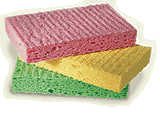 |
|||||||||||||
|
|
Spring 2007 Hey! Keep it Clean in There New Guidelines Will Help You Breathe Easy Pharmacology and Delivery Devices: What Works Best for Your Patient? Asthma Management: Barriers to Care
|
|
|
Every spring it would occur. Three weeks before Easter, we would pull out the rugs, throw them over the clothesline and beat them with a broom. We’d tie rags to a stick and wash down the walls. The basement floor would get hosed down and squeegeed. The screens would come out of the cellar and scrubbed down before they replaced the storm windows. Today it’s a little easier. We pop a wipe out of a box and, voila, instant cleaning! But one thing hasn’t changed. Spring still is the time we think about starting new projects, getting outside again and cleaning out the attic, garage or the basement. For those with breathing problems like asthma or COPD, spring cleaning can best be described as “darned if you do and darned if you don’t.” Cleaning is a necessity to reduce those allergens and triggers, but the act of cleaning and the products we use sometimes trigger a wheezing and coughing and itchy fit.
The Housework—It Has to be Done The carpets—Vaccum, vaccum, vaccum. It’s not fun, but carpets must be thoroughly cleaned. Some people will do it daily, but make sure you’re doing it at a minimum of once per week, especially in a bedroom where someone with allergies or asthma sleeps. (Of course the best option might be to eliminate carpet altogether, but let’s be realistic here.) Look for a vacuum cleaner with a HEPA filter. This keeps the particles filtered and confined within the vacuum. Make sure all the gaskets and fittings are tight so that dust doesn’t spew back out. Throw rugs—I don’t know of any better way than the old way. Take them outside and beat them with a clean broom. (Bad rugs!) The linens—Dust mites are the devil for those with asthma. First, get dust mite-proof encasings for pillows and mattresses. This definitely keeps those little critters away from a sleeping asthma sufferer. But as to the linens that go on top of these encasings, wash weekly. Use a very hot water cycle (over 130 degrees). Look for a detergent free of dyes or fragrances to further reduce the risk of a trigger.
Curtains—These are dust traps. Take them down and wash them. If you can’t, give full consideration to replacing what you have with washable options. Simple cotton curtains or blinds that can be washed down might be better alternatives for you. The tchotchkes—Knick knacks, curios, collectibles. Whatever you call them, you’ve got to clean them. That precious little “bunny with basket” is nothing but a “figurine of filth” if you don’t wipe it down from time to time. Picture frames—While you’re at it, get to those picture frames. They have a perfect ledge for collecting dust. When dusting, whether furniture, collectibles or picture frames, use a dampened cloth or one of those electrostatic cloths on the market. You don’t want that dust flying through the air. Try to do this once a month. The Walls—I’m sure you can find a better option than the rag on a stick my mother made me use, but whatever it is – a dampened dust mop, a sponge mop, or an anti-static broom, it does help to wipe down those walls. This is one of those once-a-year jobs in most places, but if you live in a dusty environment, you may need to step it up and do this more often. Dust, while it does react to gravity, is also a clever clinger on vertical surfaces. Nooks and crannies—There’s dust, droppings (yikes), mold, and muck in all those corners, window ledges, door jambs and elsewhere. You’ve just got to get in there and get it out. Those little cute cockroaches leave their waste there. Dare we consider that a mouse or worse has stopped by there? Cleaning for the Respiratory-Challenged Here’s my best tip for dealing with that: Hire someone to do it for you. Okay. Back to reality. If you do the cleaning in your house, you are likely to know what triggers your symptoms. But if not. try these tips to keep it under control.
|
|
||||||||


 Sometimes our cleaner becomes our culprit. Sponges and dishcloths are some of our biggest breeders of bacteria.
Sometimes our cleaner becomes our culprit. Sponges and dishcloths are some of our biggest breeders of bacteria.